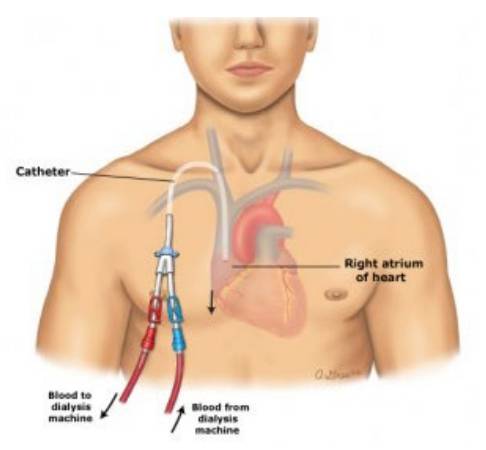Central Line Training for Schools
Please note, this page is printable by selecting the normal print options on your computer.
Central lines
Central lines are long, hollow tubes inserted into the chest under general anaesthesia. The main type of central lines used in children are known as Hickman lines. Hickman lines may have one or two lumens. Part of the tube remains outside the body, known as the exit site (see picture below). The Hickman line is used to give medicines and obtain bloods.

Care of the Hickman Line
• Hickman Lines are a foreign body, so becomes a potential gateway for infection to enter the body.
• Hickman Lines are fitted with safety clamps; these should always be clamped when the line is not in use.
• Bungs are placed at the end of each lumen to prevent infections. These should always be in place.
• Small children are provided with little bags known as “wiggle bags” that they can put around their neck to prevent the Hickman line being pulled or tugged.
• It is advised that children with Hickman Lines do not play with scissors or are supervised when using scissors to prevent accidental damage to line. Please also be aware of using badges and pins in the area of the line as these can cause punctures to the line too.
• Every child with a Hickman line should carry a line safety pack. This should be placed in an area accessible by all staff.
• Hickman lines do not prevent children from partaking in P.E but contact sports such as rugby are not recommended. Strenuous gym exercises should also be avoided as there is a risk that the Hickman Line can become dislodged.
• Children with Hickman Lines are NOT allowed to go swimming.
Breakage and Line Splits
• If the line breaks or there is a hole in it, wrap the line above the split/break in gauze and then use the blue/green clamps provided in the safety pack and clamp down as far as it will go down on the gauze.
• This is to try and prevent further damage to the line.
• Then wrap occlusive dressing provided (IV 3000) around the break. This will try and prevent infection.
• If clamps not available, bend the line above the break/split with fingers and hold.
CALL AN AMBULANCE.
In An Emergency
• In the event of the line accidentally being removed, pressure should be applied for ten minutes to the scar on the neck and the exit site on the chest (where the line comes out).
CALL AN AMBULANCE.
Contact Information
Community nurses are available Mon-Fri 8:30-16:30 for advice.
01908996521
If unable to get hold of community nurses, please call:
Ward 4 (PAU)
01908996367
Ward 5
01908996377
